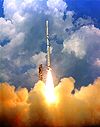Portal:Spaceflight/Selected article/Week 15 2008
The Scout family of rockets were launch vehicles designed to place small satellites into orbit around the Earth. The original Scout (an acronym for Solid Controlled Orbital Utility Test system) was designed in 1957 at the NACA Langley centre. Scouts were used from 1961 until 1994. Unlike other satellite launchers, all Scout stages were solid fuelled. To enhance reliability the development team opted to use "off the shelf" hardware, originally produced for military programmes. According to the NASA fact sheet:
... the first stage motor was a combination of the Jupiter Senior and the Navy Polaris; the second stage came from the Army MGM-29 Sergeant; and the third and fourth stage motors were designed by Langley engineers who adapted a version of the Navy Vanguard.
The first successful orbital launch of a Scout, on 16 February 1961, delivered Explorer 9, a 7 kg satellite used for atmospheric density studies, into orbit. The final launch of a Scout, using a Scout G-1, was on 9 May 1994. The payload was a MSTI military spacecraft with a mass of 163 kg, which remained in orbit until 1998. (more...)
